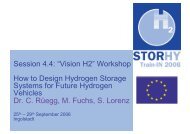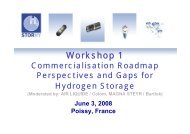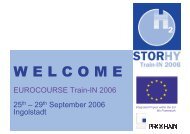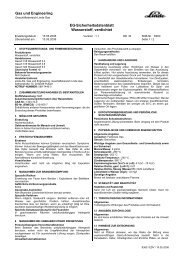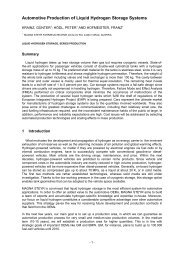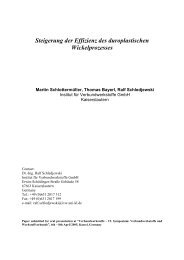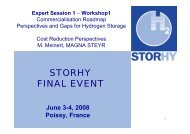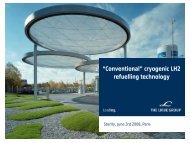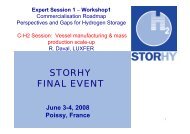Presentation for RTD trainees - StorHy Hydrogen Storage
Presentation for RTD trainees - StorHy Hydrogen Storage
Presentation for RTD trainees - StorHy Hydrogen Storage
Create successful ePaper yourself
Turn your PDF publications into a flip-book with our unique Google optimized e-Paper software.
STORHY<br />
“<strong>Hydrogen</strong> <strong>Storage</strong> Systems <strong>for</strong> Automotive Application”<br />
Integrated Project n° 502667<br />
<strong>Hydrogen</strong> and Fuel Cell Review Days 2007, Brussels 10th-11th October<br />
Volker Strubel<br />
Josef Zieger<br />
Sitra Colom<br />
Guido Bartlok<br />
Jiri Muller<br />
Georg Mair<br />
Florent Montignac<br />
Angelika Bertalanic
<strong>Hydrogen</strong> and Fuel Cell Review Days 2007, Brussels 10th-11th October<br />
1. Project Objectives<br />
<strong>StorHy</strong> – General Project In<strong>for</strong>mation<br />
“<strong>Hydrogen</strong> <strong>Storage</strong> Systems <strong>for</strong> Automotive Application”<br />
Integrated Project n° 502667 within the EU FP6<br />
Co-ordinator: MAGNA STEYR Fahrzeugtechnik AG & Co KG<br />
Time frame: 2004 – 2008 (4,5 years)<br />
Official project start: March 1 st , 2004<br />
Budget: € 18.7 m<br />
EU contribution: € 10.7 m<br />
Website: www.storhy.net<br />
34 partners from 13 European countries<br />
(5 OEMs, 14 research institutes and 15 supplier companies)
Source: Daimler Chrysler<br />
Gas:<br />
700 bar Technologies<br />
Source: Dynetek<br />
<strong>Hydrogen</strong> and Fuel Cell Review Days 2007, Brussels 10th-11th October<br />
1. Project Objectives<br />
<strong>StorHy</strong> – Overall Structure<br />
Users:<br />
Vehicle Requirements<br />
Source: BMW<br />
Source: PSA Source: Daimler Chrysler<br />
Liquid:<br />
Lightweight<br />
Free-<strong>for</strong>m Tank<br />
Source: SP Cryo<br />
Safety Aspects and Requirements<br />
Multi-Criteria Evaluation<br />
Solid:<br />
Advanced Alanates<br />
Source: IFE
<strong>Hydrogen</strong> and Fuel Cell Review Days 2007, Brussels 10th-11th October<br />
1. Project Objectives<br />
<strong>Hydrogen</strong> <strong>Storage</strong>: Consumer Expectations<br />
Public Acceptance of <strong>Hydrogen</strong> Applications –<br />
Study by DC<br />
Main conditions <strong>for</strong> consumer acceptance of FC vehicles*<br />
� Driving range<br />
� Refuelling process<br />
� High safety level<br />
� Vehicle costs<br />
� Communication / education<br />
*Excerpt only!
Consumer<br />
Expectations<br />
Driving range<br />
> 400 km – 600 km<br />
Driving per<strong>for</strong>mance<br />
Usable space<br />
Refuelling<br />
convenient and safe<br />
Safety<br />
<strong>Hydrogen</strong> and Fuel Cell Review Days 2007, Brussels 10th-11th October<br />
1. Project Objectives<br />
<strong>StorHy</strong>:<strong>Hydrogen</strong> <strong>Storage</strong> Requirements<br />
Technical<br />
Requirements<br />
Unit <strong>StorHy</strong><br />
Targets 2010<br />
<strong>Hydrogen</strong> storage mass kg 6 - 10<br />
System grav. energy density kWh/kg<br />
wt.%<br />
System vol. energy density kWh/l<br />
kg H 2 /100l<br />
Filling cycles 3*5,000<br />
Loss of usable H2 (boil-off) g/h *stored<br />
kg H2 1<br />
Vehicle costs Costs of storage system €/ kg H2 Not defined<br />
2.0<br />
6<br />
1.5<br />
4.5<br />
Refuelling rate kg H 2 /min 1.2<br />
Burst pressure 700 bar bar 1,645<br />
Permeation rate H 2 Ncm 3 /h *l EHIP II<br />
1
International technology watch<br />
� Increase of service pressure from 350 bar – 700 bar<br />
� 700 bar Type III fully wrapped aluminum liner<br />
� 700 bar Type IV fully wrapped non-load carrying plastic liner<br />
� 700 bar system prototypes or small series announced in<br />
USA, Japan and Europe<br />
<strong>Hydrogen</strong> and Fuel Cell Review Days 2007, Brussels 10th-11th October<br />
2. Alignment to SRA/DS<br />
Compressed <strong>Hydrogen</strong> <strong>Storage</strong>:<br />
State-of-the-Art<br />
Source: Dynetek
700 bar Type III vessel with<br />
metallic liner made by deep drawing<br />
� Material & microstructure<br />
– Modified CrMo steels<br />
� Liner material characterization<br />
– 5 steels assessed concerning H 2<br />
embrittlement<br />
� 700 bar design & calculation<br />
– Analytical + FE calculations <strong>for</strong><br />
composite thickness + optimized<br />
modulus (fibre type) + winding path<br />
� Vessel testing<br />
– Ambient T cycling < 15,000 cycles<br />
– Burst factor: > 2.35<br />
– Other EIHP-II tests were per<strong>for</strong>med<br />
successfully<br />
<strong>Hydrogen</strong> and Fuel Cell Review Days 2007, Brussels 10th-11th October<br />
2. Alignment to SRA/DS<br />
<strong>StorHy</strong>: 700 bar C-H 2 Vessels<br />
Source: AL<br />
Source: Faber<br />
Source: Faber<br />
Technical data:<br />
• Mass of vessel: 40 kg<br />
• Internal volume: 39 l<br />
• H 2 storage capacity: 3.85 wt.%<br />
• Operating pressure: 700 bar<br />
• H 2 mass stored: 1.6 kg
700 bar Type IV vessel with<br />
rotomoulded plastic liner<br />
� Polymeric material & microstructure<br />
– Development of specific PA6 <strong>for</strong>mation<br />
(permeation / mechanical elasticity /<br />
processability)<br />
� Liner material characterization:<br />
Permeation of PA polymer liner assessed<br />
at 700 bar f (T, p):<br />
– Material level: Pe ∼1*10-16mol/(Pa.s.m) – Vessel level: ongoing<br />
� 700 bar vessel design & calculation<br />
– Analytical + FE calculations<br />
<strong>for</strong> composite thickness<br />
� Vessel testing<br />
– Ambient T cycling > 15,000 cycles<br />
– Burst factor: 2.2<br />
<strong>Hydrogen</strong> and Fuel Cell Review Days 2007, Brussels 10th-11th October<br />
2. Alignment to SRA/DS<br />
<strong>StorHy</strong>: 700 bar C-H2 Vessels<br />
Source: CEA/Ullit<br />
Source: CEA<br />
Technical data:<br />
• Mass of vessel: 29 kg<br />
• Internal volume: 37 l<br />
• H 2 storage capacity: 5.2 wt.%<br />
• Operating pressure: 700 bar<br />
• H 2 mass stored: 1.6kg
<strong>Hydrogen</strong> and Fuel Cell Review Days 2007, Brussels 10th-11th October<br />
2. Alignment to SRA/DS<br />
<strong>StorHy</strong>: Test Results of C-H 2 Vessels<br />
Type III<br />
(steel liner)<br />
Type IV<br />
(PA liner)<br />
Thermoplastic<br />
modular system<br />
Burst test Passed Close to target Feasibility GF/PP<br />
Cycling test Not passed Passed Not tested yet<br />
Status<br />
Cycling behaviour<br />
to be improved<br />
Burst behaviour to<br />
be improved<br />
Feasibility at<br />
300 bar<br />
Typical failure mechanisms <strong>for</strong> C-H 2 vessels identified<br />
Measured proposed <strong>for</strong> further improvements steps:<br />
� R&D activities required <strong>for</strong> a fundamental understanding of<br />
aging & failure behaviour composite and liner materials,<br />
advanced modelling and simulation concepts
Steel liner<br />
Production<br />
Polymer liner<br />
Production:<br />
Rotomolding<br />
<strong>Hydrogen</strong> and Fuel Cell Review Days 2007, Brussels 10th-11th October<br />
<strong>StorHy</strong> contribution (excerpt)<br />
Liner fabrication Composite manufacturing Post processing<br />
Alu liner<br />
Production<br />
Polymer liner<br />
Production:<br />
Blow<strong>for</strong>ming<br />
2. Alignment to SRA/DS<br />
C-H 2 <strong>Storage</strong>: Production Steps<br />
CF raw materials Impregnation bath<br />
Filament winding Curing<br />
Autofrettage<br />
Process<br />
Vessel testing<br />
Recycling<br />
Dismantling<br />
Shreddering<br />
CF Recycling
Ring winding head with modular siphon impregnation<br />
units and suitable advancement of the path generation<br />
� Increase of the lay-down rate (> factor 3)<br />
� Better exploitation of the fibre per<strong>for</strong>mance, which entails weight<br />
reduction potentials <strong>for</strong> pressure vessels<br />
� Clean work station due to an almost closed system<br />
� Reduction of resin consumption<br />
� Almost no hazardous waste<br />
Winner of two Innovation Awards!<br />
<strong>Hydrogen</strong> and Fuel Cell Review Days 2007, Brussels 10th-11th October<br />
2. Alignment to SRA/DS<br />
<strong>StorHy</strong>: C-H 2 Vessel Production –<br />
Improved Winding and Impregnation<br />
Source: IVW
� Development of pre-treatment technology<br />
– Hybrid shredder (Kema) selected<br />
<strong>Hydrogen</strong> and Fuel Cell Review Days 2007, Brussels 10th-11th October<br />
2. Alignment to SRA/DS<br />
<strong>StorHy</strong>: C-H 2 Composite Vessel<br />
Recycling Concepts<br />
� Development of recycling processes<br />
– Fluidised bed process selected<br />
– Good quality fibre (similar stiffness<br />
Clean flue<br />
and 50% strength) has been recycled gas<br />
To energy<br />
recovery<br />
� R&D to increase material recycling rate: Afterburner<br />
– Microwave pyrolysis process in a<br />
fluidised bed<br />
– 86% total material recovery achieved<br />
(increase from 63% <strong>for</strong> fluidised bed) Air Inlet<br />
� Recycling of a thermoplastic composite<br />
vessel by granulation and injection moulding<br />
demonstrated (GF/PP COMAT system)<br />
Recovered<br />
Source: UNOTT<br />
CF fibre<br />
Twin screw shredder<br />
Fluidised Bed Recycling<br />
Cyclone<br />
300 mm<br />
Scrap CFRP<br />
Fan<br />
Recovered Fluidised<br />
Fibre<br />
Bed<br />
Electric Pre-heaters<br />
Air distributor<br />
plate
High pressure H 2<br />
V 1<br />
Booster Cooler<br />
<strong>Hydrogen</strong> and Fuel Cell Review Days 2007, Brussels 10th-11th October<br />
2. Alignment to SRA/DS<br />
Refuelling C-H 2 : State-of-the-Art<br />
V 2<br />
700 bar filling nozzle<br />
Source: Weh<br />
� For fast filling, gaseous<br />
hydrogen needs to be cooled<br />
down to prevent excessive<br />
pressure and temperature<br />
levels<br />
� <strong>Hydrogen</strong> cooler required in<br />
the refuelling station!<br />
Source: Linde / Aral
Fast filling demonstrated on vessel<br />
level<br />
� Filling temperature down to -100°C<br />
demonstrated<br />
� 100% filling rate easy to reach<br />
� Gentle cylinder treatment compared to<br />
warm filling – but thermal stress <strong>for</strong><br />
storage components, esp. sealing<br />
� Cooling down to -40 °C seems to be<br />
good compromise<br />
� Deeper cooling still needs to be<br />
evaluated with regard to costs and<br />
material exposure<br />
700 bar cold (–40°C) filling test in<br />
F-Cell vehicle<br />
� Safe and optimized filling demonstrated Source: ET, AL, Dynetek, DC, Weh<br />
<strong>Hydrogen</strong> and Fuel Cell Review Days 2007, Brussels 10th-11th October<br />
2. Alignment to SRA/DS<br />
<strong>StorHy</strong>: C-H 2 Cold Filling<br />
Technical data:<br />
• Filling T: -85°C<br />
• Filling time:
Advanced C-H 2 700 bar filling devices<br />
developed and tested:<br />
� Filling nozzle with infrared<br />
communication interface<br />
� Linear shut-off valve<br />
� Break-away device<br />
Sources: WEH<br />
<strong>Hydrogen</strong> and Fuel Cell Review Days 2007, Brussels 10th-11th October<br />
2. Alignment to SRA/DS<br />
<strong>StorHy</strong>: C-H 2 700 bar Filling Devices<br />
Source: Weh<br />
Break-away device with<br />
infrared communications<br />
interface<br />
Linear shut-off valve<br />
Filling nozzle with/without infrared<br />
communication interface<br />
Start of commercialization
Source: MAGNA STEYR<br />
<strong>Hydrogen</strong> and Fuel Cell Review Days 2007, Brussels 10th-11th October<br />
2. Alignment to SRA/DS<br />
Cryogenic Liquid <strong>Storage</strong> System<br />
International technology watch<br />
� Small series, automotive, approved L-H 2 storage systems with<br />
double-walled stainless cylinders<br />
� First cylindrical prototypes with lightweight aluminum tank<br />
shells<br />
� First flat-shaped prototypes with lightweight steel tank shells<br />
Source: Linde<br />
Source: Air Liquide
Structure and coating concepts <strong>for</strong> liner<br />
Moisture, air, oil, etc<br />
<strong>Hydrogen</strong><br />
Outgassing<br />
Outgassing<br />
<strong>Hydrogen</strong> and Fuel Cell Review Days 2007, Brussels 10th-11th October<br />
2. Alignment to SRA/DS<br />
<strong>StorHy</strong>: L-H2 Lightweight Design<br />
Lightweight cylindrical tank<br />
Carbon fibre composite structure of inner tank and outer jacket<br />
Liner<br />
Outer Jacket Composite<br />
High Vacuum: 10 -5 – 10 -6 Liner<br />
mBar<br />
Liner<br />
Inner Tank Composite<br />
<strong>Hydrogen</strong><br />
Aluminium sheet (outer jacket)<br />
Galvanic copper coating<br />
(inner tank)<br />
Source: SP Cryo
Free-<strong>for</strong>m tank system with auxiliary system box<br />
Free-<strong>for</strong>m design<br />
<strong>Hydrogen</strong> and Fuel Cell Review Days 2007, Brussels 10th-11th October<br />
2. Alignment to SRA/DS<br />
<strong>StorHy</strong>: L-H 2 Free-<strong>for</strong>m Design<br />
Risk analysis<br />
(FMEA and FTA)<br />
Free-<strong>for</strong>m tank<br />
demonstrator<br />
Source: SP Cryo<br />
Concept calculation<br />
(e.g. showing de<strong>for</strong>mation<br />
at 10.8 bar)<br />
Vehicle integration<br />
concepts
Weight [kg]<br />
Mass comparison of gasoline and L-H 2 tank systems<br />
Energy content equivalent to 10 kg hydrogen<br />
200<br />
175<br />
150<br />
125<br />
100<br />
75<br />
50<br />
25<br />
0<br />
10 kg<br />
<strong>Hydrogen</strong> and Fuel Cell Review Days 2007, Brussels 10th-11th October<br />
2. Alignment to SRA/DS<br />
<strong>StorHy</strong>: L-H 2 Weight Reduction Potential<br />
3<br />
30<br />
65<br />
100 kg<br />
Gasoline 38 dm³ LH2 Steel<br />
E 68<br />
cylindrical shape<br />
25<br />
40 kg<br />
10 10 10<br />
LH2 Lightweight<br />
<strong>StorHy</strong><br />
cylindrical shape<br />
Auxiliary System<br />
Tank<br />
Fuel<br />
20<br />
25 kg<br />
LH2 Lightweight<br />
2010<br />
complex shape<br />
Source: SP Cryo
Pre-processing<br />
Component<br />
production<br />
Valves, Sensor<br />
Prepreg<br />
(e.g. knitting)<br />
Piping<br />
Insulation<br />
Alu liner<br />
<strong>StorHy</strong> contribution (excerpt SP Cryo)<br />
<strong>Hydrogen</strong> and Fuel Cell Review Days 2007, Brussels 10th-11th October<br />
2. Alignment to SRA/DS<br />
Manufacturing process CFRP tank<br />
CFRP inner tank manufacturing<br />
Tension<br />
sheet<br />
Dome &<br />
pipes<br />
Inner tank - coating of liner<br />
CFRP outer jacket manufacturing<br />
Impregnation<br />
Curing<br />
Source: SP Cryo<br />
Post-processing<br />
Assembly<br />
Welding<br />
Evacuation of<br />
insulation gap<br />
Testing
International technology watch<br />
� Intensive international R&D ef<strong>for</strong>ts focus on different types of materials<br />
and storage systems<br />
But:<br />
� None of these materials fulfills automotive targets (storage density,<br />
operation temperature etc.) yet!<br />
<strong>Hydrogen</strong> and Fuel Cell Review Days 2007, Brussels 10th-11th October<br />
2. Alignment to SRA/DS<br />
Solid <strong>Storage</strong><br />
• Metal and complex<br />
hydrides<br />
• Chemical hydrides<br />
• Nanoporous<br />
structures<br />
Source: DoE 2007
<strong>Storage</strong> Material<br />
Magnesium Alanate<br />
• Mg(AlH4 ) 2 : Solvent-free and fast synthesis<br />
• Deuterised Mg(AlD4 ) 2 <strong>for</strong> neutron diffraction<br />
• Structure of Mg(AlH 4 ) 2 : Neutron and<br />
synchrotron X-ray diffraction<br />
• Details of thermal and isothermal<br />
decomposition of Mg(AlH4 ) 2<br />
Sodium Alanate<br />
• Purification of NaAlH4 and synthesis of<br />
NaAlD4 Catalyst<br />
• Improved synthesis of catalyst: Ti13 *6THF<br />
<strong>Hydrogen</strong> and Fuel Cell Review Days 2007, Brussels 10th-11th October<br />
2. Alignment to SRA/DS<br />
<strong>StorHy</strong>: Characterisation of Alanates<br />
First step: Magnesium and Sodium Alanates<br />
Automotive Challenges<br />
Scale-up strategies<br />
promising, but<br />
reversibility not sufficient!<br />
Source: IFE<br />
Source: FZK<br />
Scale-up strategies<br />
promising, but material<br />
storage density of 3 wt. %<br />
not sufficient<br />
Source: IFE, FZK
<strong>Storage</strong> Material<br />
Screening experiments <strong>for</strong> synthesis and<br />
characterization <strong>for</strong> new mixed alanates:<br />
• Mg-Al-Li-H, Mg-Al-Ca-H, Ca-Al-Li-H, Ca-Al-Na-H<br />
• Mg-Al-Li-H, Mg-Al-Ca-H, Mg-Al-Na-H, Mg-Al-K-H<br />
• Mg-Al-Li-H, Mg-Al-Ca-H, Ca-Al-K-H<br />
Synthesis and stabilisation of aluminium hydride<br />
AlH3 (Alane) – basic research purpose<br />
vial<br />
<strong>Hydrogen</strong> and Fuel Cell Review Days 2007, Brussels 10th-11th October<br />
2. Alignment to SRA/DS<br />
<strong>StorHy</strong>: Screening <strong>for</strong> new Alanates<br />
Second step: Adaptation of work programme<br />
stainless<br />
steel<br />
impactor<br />
liquid nitrogen<br />
Spex 6750 freezer mill <strong>for</strong> cryomilling<br />
Source: IFE, FZK, GKSS<br />
INTENSITY (arb. units)<br />
8000<br />
6000<br />
4000<br />
2000<br />
800<br />
0<br />
α'-AlD 3 and α-AlD 3<br />
PND, Kjeller<br />
-800<br />
10 20 30 40 50 60 70 80 90 100 110 120 130<br />
2θ(º)<br />
Automotive Challenges<br />
No new reversible<br />
hydrogen storage<br />
compound found<br />
No break-through up to<br />
now<br />
High material storage<br />
density 10.1%, but not<br />
reversible!<br />
Simplified method to<br />
synthesize AlH 3 by milling at<br />
liquid nitrogen temperature,<br />
compared to wet chemistry<br />
Work in progress to change<br />
the stability of AlH 3
H 2 -concentration [wt.%]<br />
5<br />
4<br />
3<br />
2<br />
1<br />
2nd absorption<br />
Concept <strong>for</strong> upscaling of material production processes<br />
preparation<br />
from NaAlH4 simple preparation with Ti-nano<br />
from NaH/Al clusters,<br />
with TiCl , 125°C 100°C, 100 bar<br />
4<br />
100 bar (STORHY)<br />
(Fichtner et al.)<br />
preparation from<br />
NaAlH with TiCl , 125°C, 79-88 bar<br />
4 3<br />
(Sandrock et al.)<br />
0<br />
0 10 20 30 40 50 60<br />
Time [min.]<br />
Design and development of operational prototype solid storage tanks<br />
Laboratory tank <strong>for</strong> 0.5 kg of alanate<br />
Length: 40 cm / Diameter: 6 cm<br />
Capacity: 20 g H 2<br />
<strong>Hydrogen</strong> and Fuel Cell Review Days 2007, Brussels 10th-11th October<br />
2. Alignment to SRA/DS<br />
<strong>StorHy</strong>: Upscaling of Solid <strong>Storage</strong> Tank<br />
� Evaluation of low cost<br />
production routes <strong>for</strong> complex<br />
hydrides using catalysed NaAlH 4<br />
as model material<br />
� Up-scaling to kg amounts<br />
demonstrated at GKSS mechanical<br />
processing facility<br />
Source: GKSS/TUHH<br />
8 kg alanate Pilot tank<br />
(currently manufactured)<br />
Length: 120 cm, Diameter: 22 cm<br />
Capacity: 0.4 kg H 2,
Calculated per<strong>for</strong>mance of tanks based on lab-scale data (NaAlH 4 )<br />
<strong>Hydrogen</strong> absorbed in g<br />
400<br />
350<br />
300<br />
250<br />
200<br />
150<br />
100<br />
50<br />
Concept <strong>for</strong> filling<br />
� Hydride tank is cooled by external heat<br />
consumer working at approx. 100°C<br />
� Coupling of hydrogen and heat transfer<br />
medium prior to filling<br />
Concept <strong>for</strong> driving<br />
� Fuel cell is cooled to 80°C by hydride<br />
tank and internal heat exchanger<br />
0<br />
Alpha version<br />
100°C<br />
130°C<br />
290 s 458 s 540 s<br />
<strong>Hydrogen</strong> and Fuel Cell Review Days 2007, Brussels 10th-11th October<br />
273<br />
Oil<br />
625<br />
10<br />
1<br />
2 3<br />
9<br />
8<br />
7 6<br />
5 4 3<br />
2<br />
0 200 400 600 800 1000<br />
tins<br />
Ø 6<br />
Ø 10<br />
1236<br />
310 g<br />
4<br />
8<br />
5<br />
Simulation based on kinetic<br />
data obtained from optimized<br />
<strong>StorHy</strong> material produced in<br />
kg scale<br />
2. Alignment to SRA/DS<br />
<strong>StorHy</strong>: Solid Filling<br />
External<br />
Heat<br />
Consumer<br />
Quick coupling<br />
Internal heat<br />
exchanger<br />
Fuel cell<br />
Vehicle<br />
Source: NCSRD/GKSS/TUHH<br />
Heat<br />
transfer<br />
medium<br />
Hydride<br />
Tank<br />
<strong>Hydrogen</strong><br />
Less than 10 min. charging<br />
time expected even in costeffective<br />
design (pilot tank)
� Assessment of test procedures <strong>for</strong> C-H 2 vessels<br />
<strong>Hydrogen</strong> and Fuel Cell Review Days 2007, Brussels 10th-11th October<br />
Bonfire<br />
� Interlaboratory tests at various European test facilities<br />
� Validation of hydrogen sensors<br />
3. Cross-cutting Issues:<br />
<strong>StorHy</strong>: Safety Assessment
-90°<br />
Development of test procedures <strong>for</strong> C-H 2 vessels:<br />
Impact test<br />
Estimation of<br />
statistical crash energies<br />
-60°<br />
-120°<br />
Polarplot Crashenergy [KJ]<br />
-30°<br />
-150°<br />
300<br />
250<br />
200<br />
150<br />
100<br />
50<br />
0<br />
<strong>Hydrogen</strong> and Fuel Cell Review Days 2007, Brussels 10th-11th October<br />
0°<br />
180°<br />
10%<br />
50%<br />
90%<br />
99%<br />
Source: BAM, Cidaut<br />
3. Cross-cutting Issues:<br />
<strong>StorHy</strong>: Safety Assessment of C-H 2 <strong>Storage</strong><br />
30°<br />
150 °<br />
60°<br />
120°<br />
90°<br />
Estimation of energy<br />
impacting on storage<br />
system in crash models<br />
Assessment of the<br />
residual burst strength<br />
Vessel impact tests
of Solid <strong>Storage</strong> Materials<br />
Alanate powder release experiments<br />
<strong>Hydrogen</strong> and Fuel Cell Review Days 2007, Brussels 10th-11th October<br />
Ignition by water droplets<br />
Flame 240 ms 240 ms<br />
560 ms<br />
3. Cross-cutting Issues:<br />
<strong>StorHy</strong>: Chemical Safety Experiments<br />
1. Disk bursts at p = 10 bar<br />
2. Material is released into various environments<br />
30 ms 60 ms<br />
3. High speed images<br />
4. Assessment of sound levels<br />
Source: FZK<br />
opening of burst disc<br />
560 ms<br />
Pure hydrogen<br />
reproduction<br />
2005<br />
Water mist<br />
Spark ignition
Multi-criteria evaluation<br />
� Five different evaluation domains addressed<br />
<strong>Hydrogen</strong> and Fuel Cell Review Days 2007, Brussels 10th-11th October<br />
Technical per<strong>for</strong>mance<br />
Costs Safety<br />
Environmental impact<br />
3. Cross-cutting Issues:<br />
<strong>StorHy</strong>: Evaluation<br />
� Focus on technical and environmental parameters<br />
Social acceptance<br />
Source: CEA
Volumetric energy density [kg H 2 /100 l]<br />
Comparison of system storage densities<br />
5.00<br />
4.00<br />
3.00<br />
2.00<br />
1.00<br />
0.00<br />
Solid <strong>Storage</strong><br />
System Reference<br />
Solid <strong>Storage</strong> <strong>StorHy</strong><br />
System NaAlH 4<br />
(Not yet optimised)<br />
0.00 2.00 4.00 6.00 8.00 10.00 12.00 14.00 16.00 18.00 20.00<br />
Gravimetric energy density [wt.%]<br />
<strong>Hydrogen</strong> and Fuel Cell Review Days 2007, Brussels 10th-11th October<br />
?<br />
C-H 2 <strong>StorHy</strong> 700 bar<br />
Swap Rack<br />
C-H 2 Referenc 350 bar<br />
Swap Rack<br />
<strong>StorHy</strong> target<br />
6 wt.%<br />
<strong>StorHy</strong> Target<br />
4.5 kg H 2 /100 l<br />
C-H 2 <strong>StorHy</strong> System Type IV 700<br />
bar (extrap.)<br />
C-H 2 Reference System<br />
Typ III H 2 350 bar<br />
4. Future Perspectives<br />
<strong>StorHy</strong>: Evaluation<br />
L-H 2 <strong>StorHy</strong> System<br />
Lightweight Free-<strong>for</strong>m<br />
(extrap.)<br />
L-H 2 <strong>StorHy</strong> System<br />
Lightweight Cylindrical<br />
L-H 2 Reference System<br />
Stainless Steel
Medium-class Car: Fuel cell vehicle with C-H 2 storage<br />
Today:<br />
� Driving range lower<br />
than 400 km<br />
e.g. F-Cell 2002<br />
Source: DC<br />
Power el.: 72 kW<br />
<strong>Hydrogen</strong> mass: 1.9 kg<br />
C-H2 storage: 350 bar<br />
Max. speed: 150 km/h<br />
Range: 150 km<br />
<strong>Hydrogen</strong> and Fuel Cell Review Days 2007, Brussels 10th-11th October<br />
4. Future Perspectives<br />
<strong>Hydrogen</strong> <strong>Storage</strong> in different<br />
Vehicle Concepts<br />
Tomorrow:<br />
� Driving range of 400 km to 500 km by<br />
700 bar C-H2 storage systems<br />
e.g. F600 Hygenius Concept Car<br />
Source: DC<br />
Cooling<br />
System<br />
System<br />
module<br />
Power: 60/85 kW<br />
<strong>Hydrogen</strong> mass: 4 kg<br />
C-H2 storage: 700 bar<br />
Max. speed: 174 km/h<br />
Range: >400 km<br />
Source: DC<br />
Battery
Delivery van: FC City Car with range extender<br />
Today: Tomorrow:<br />
Source: PSA<br />
Power el. 28 kW<br />
Max. speed: 95 km/h<br />
FC power 5 kW<br />
Battery: 15 kWh<br />
<strong>Hydrogen</strong> C-H2 @350bar: 1,6 kg<br />
Range H2 : 70 km<br />
Range Battery: 80 km<br />
<strong>Hydrogen</strong> and Fuel Cell Review Days 2007, Brussels 10th-11th October<br />
4. Future Perspectives<br />
<strong>Hydrogen</strong> <strong>Storage</strong> in different<br />
Vehicle Concepts<br />
Source: PSA<br />
Power 28 kW<br />
Max. speed: 95 km/h<br />
FC power: 10 kW<br />
Battery: 15 kWh<br />
<strong>Hydrogen</strong> C-H2 @700bar: 2,7 kg<br />
Range H2 : 170 km<br />
Range Battery: 80 km
Today: Tomorrow:<br />
Bi-Fuel (L-H 2 + Gasoline)<br />
Source: MAGNA STEYR<br />
Power: 191 kW (260 bhp)<br />
<strong>Hydrogen</strong> mass: > 8 kg<br />
L-H2 storage: Stainless steel<br />
Cylindrical<br />
Range H2 : > 200 km<br />
+ Range Gasoline: > 500 km<br />
<strong>Hydrogen</strong> and Fuel Cell Review Days 2007, Brussels 10th-11th October<br />
Source: BMW<br />
4. Future Perspectives<br />
<strong>Hydrogen</strong> <strong>Storage</strong> in different<br />
Vehicle Concepts<br />
<strong>Hydrogen</strong> ICE with L-H 2 <strong>Storage</strong><br />
Monofuel (L-H 2)<br />
- Highly efficient hydrogen ICE<br />
- Lightweight cryogenic storage<br />
Power: > 100 kW (136 bhp)<br />
<strong>Hydrogen</strong> mass: > 7 kg<br />
L-H2 storage: Lightweight<br />
Free-<strong>for</strong>m shape<br />
Range H2 : > 500 km<br />
+
C-H 2 storage<br />
� <strong>Storage</strong> densities of ~4.5 wt.% and ~2.4 kg H 2/100 l are achievable<br />
on system level<br />
� <strong>StorHy</strong> results regarding C-H 2 vessels close up to worldwide R&D<br />
� Further optimisation requires fundamental understanding of<br />
ageing and failure behaviour of composite and liner materials,<br />
modelling and simulation concepts<br />
� <strong>StorHy</strong> results on filling components and production concepts<br />
show promising advanced solutions<br />
� Further cost reduction requires new industrialisation concepts <strong>for</strong><br />
mass production and new CF fibres<br />
� Higher storage densities and further cost reduction require change<br />
of Regulations, Codes & Standards as well as new vehicle<br />
plat<strong>for</strong>ms (e.g. compatible with single cylinder storage concepts)<br />
� New advanced safety approach necessary in the future, e.g. based<br />
on Probabilistic Safety Assessment<br />
<strong>Hydrogen</strong> and Fuel Cell Review Days 2007, Brussels 10th-11th October<br />
4. Future Perspectives<br />
<strong>StorHy</strong>: Preliminary Conclusions
L-H 2 storage<br />
� <strong>Storage</strong> densities up to 14 wt.% and 4 kg H 2/100 l are achievable on<br />
system level <strong>for</strong> metal design, even up to 18 wt.% using advanced<br />
composite materials<br />
� <strong>StorHy</strong> results demonstrate a free <strong>for</strong>m tank design with improved<br />
con<strong>for</strong>mability to better enable vehicle integration<br />
� <strong>StorHy</strong> results show promising advanced solutions beyond<br />
worldwide R&D, but still further R&D ef<strong>for</strong>ts are required <strong>for</strong><br />
industrialisation and system validation<br />
� Substantial cost reduction is indispensable<br />
� Lightweight L-H 2 storage systems show considerable potential in<br />
combination with new H 2 ICE<br />
� Further L-H 2 specific challenges, such as boil-off and permeation,<br />
have to be addressed<br />
<strong>Hydrogen</strong> and Fuel Cell Review Days 2007, Brussels 10th-11th October<br />
4. Future Perspectives<br />
<strong>StorHy</strong>: Preliminary Conclusions
Solid <strong>Storage</strong> (1)<br />
� Up to now, storage densities of ~2 wt.% are achieveable on system<br />
level with complex hydrides on alanate basis<br />
� At present, no solid storage material fulfils the major targets <strong>for</strong><br />
automotive applications<br />
� <strong>StorHy</strong> tank development demonstrates feasibility of a fast heat<br />
removal using lightweight complex hydrides<br />
� <strong>StorHy</strong> safety study shows minimised explosion in case of<br />
hydrogen release<br />
� <strong>StorHy</strong> up-scaling results show high potential <strong>for</strong> mass production<br />
of complex light weight hydrides at low costs<br />
<strong>Hydrogen</strong> and Fuel Cell Review Days 2007, Brussels 10th-11th October<br />
4. Future Perspectives<br />
<strong>StorHy</strong>: Preliminary Conclusions
Solid <strong>Storage</strong> (2)<br />
� Further research <strong>for</strong> novel storage materials with improved storage<br />
densities, kinetics and thermodynamic behaviour as well as <strong>for</strong><br />
advanced system components, e.g. heat exchanger, is still required<br />
� Automotive solutions are not realistic in the medium term<br />
� Stationary or marine applications have more potentials <strong>for</strong> a market<br />
entry in the near future<br />
<strong>Hydrogen</strong> and Fuel Cell Review Days 2007, Brussels 10th-11th October<br />
4. Future Perspectives<br />
<strong>StorHy</strong>: Preliminary Conclusions
General conclusions<br />
Beyond <strong>StorHy</strong>, further R&D activities are proposed <strong>for</strong>:<br />
� In-depth system/vehicle validation in demonstration projects<br />
� Industrialisation and cost reduction concepts<br />
� Safety assessment and new advanced safety approaches<br />
� Optimisation of Regulations, Codes & Standards (e.g design<br />
requirements <strong>for</strong> pressure vessels)<br />
� New storage concepts, such as pressure tanks with new high<br />
per<strong>for</strong>mance tensile fibres, hybrid tanks (pressure / cryogenic /<br />
solid storage), etc.<br />
� User-oriented fundamental research on solid storage materials,<br />
their safety and technical development of solid storage tanks<br />
<strong>Hydrogen</strong> and Fuel Cell Review Days 2007, Brussels 10th-11th October<br />
4. Future Perspectives<br />
<strong>StorHy</strong>: Preliminary Conclusions
<strong>Hydrogen</strong> and Fuel Cell Review Days 2007, Brussels 10th-11th October<br />
More in<strong>for</strong>mation?<br />
Join the<br />
4. Future Perspectives<br />
<strong>StorHy</strong> Dissemination<br />
<strong>StorHy</strong> Dissemination Event:<br />
“<strong>Hydrogen</strong> <strong>Storage</strong> Perspectives of the Future”<br />
Date: June 2008<br />
Further in<strong>for</strong>mation shortly on www.storhy.net!<br />
Or contact: volker.strubel@magnasteyr.com
<strong>Hydrogen</strong> and Fuel Cell Review Days 2007, Brussels 10th-11th October<br />
Backup only!
<strong>Hydrogen</strong> and Fuel Cell Review Days 2007, Brussels 10th-11th October<br />
Source: MAGNA STEYR<br />
Back up<br />
L-H 2 <strong>Storage</strong> System<br />
Outer jacket<br />
- Outer vessel<br />
- Thermal insulation<br />
- Refueling interface<br />
- Outer support<br />
Inner tank<br />
- Inner vessel<br />
- Level measurement<br />
-Pipework<br />
- Cryogenic shut-off valves<br />
- Inner tank support<br />
Auxiliary System Box<br />
- Shut-off valves<br />
- Control valve<br />
- Safety relief valves<br />
- Sensors (p, T, H 2 )<br />
- Heat exchanger
Solenoid<br />
valve<br />
Venting<br />
pipe<br />
Fixing<br />
Electrical<br />
connections<br />
Source: Dynetek<br />
Valves,<br />
Fittings<br />
Pressure<br />
regulator<br />
<strong>Hydrogen</strong> and Fuel Cell Review Days 2007, Brussels 10th-11th October<br />
Sensors<br />
Low<br />
pressure<br />
connection<br />
Back up<br />
C-H 2 <strong>Storage</strong> System<br />
High<br />
pressure<br />
vessel<br />
High<br />
pressure<br />
connection<br />
Type 3<br />
Type 4<br />
Fully wrapped<br />
cylinder &<br />
metallic liner<br />
Fully wrapped<br />
cylinder &<br />
non-load carrying<br />
(plastic) liner
Source: Dynetek<br />
<strong>Hydrogen</strong> and Fuel Cell Review Days 2007, Brussels 10th-11th October<br />
Back up<br />
C-H 2 <strong>Storage</strong> Reference System<br />
Source: SP Users
Source: Magna Steyr<br />
<strong>Hydrogen</strong> and Fuel Cell Review Days 2007, Brussels 10th-11th October<br />
Back up<br />
L-H 2 <strong>Storage</strong> Reference System<br />
Source: SP Users
Source: DC<br />
<strong>Hydrogen</strong> and Fuel Cell Review Days 2007, Brussels 10th-11th October<br />
Back up<br />
Solid <strong>Storage</strong> Reference System<br />
Source: SP Users
� Material & microstructure<br />
– Extruded multi-layer based PA<br />
� Liner material characterization<br />
– 8 multilayer polymers assessed: f (p,T)<br />
– Permeation: 2*10-18mol/(Pa.s.m) -> OK<br />
� 700 bar vessel design & calculation<br />
– Optimized end cap design<br />
– CF/PA 700 bar system<br />
– GF/PP 200 bar system<br />
� CF <strong>for</strong> this thermoplastic composite not<br />
available yet!<br />
� Vessel testing (GF/PP)<br />
– Burst pressure = 460 bar<br />
<strong>Hydrogen</strong> and Fuel Cell Review Days 2007, Brussels 10th-11th October<br />
Back up<br />
<strong>StorHy</strong>: 700 bar C-H 2 Vessels<br />
700 bar modular system with extruded plastic liner<br />
and thermoplastic composite<br />
Source: COMAT<br />
Technical data (CF/PA design):<br />
• Mass of vessel: 10.9 kg<br />
• Internal volume: 9 l<br />
• H 2 storage capacity: 3.5 wt.%<br />
• Design pressure: 700 bar<br />
• H 2 mass stored: 0.4 kg
Type Measure Ef<strong>for</strong>t Contribution<br />
IV<br />
IV<br />
IV<br />
III<br />
III/IV<br />
III/IV<br />
III/IV<br />
III/IV<br />
III/IV<br />
Improve burst behavior<br />
(design, process)<br />
<strong>Hydrogen</strong> and Fuel Cell Review Days 2007, Brussels 10th-11th October<br />
Low 100% burst<br />
Temperature cycling + burst Low Reliability of Type IV<br />
Evaluate tightness after thermal &<br />
mechanical ageing (=> depending on<br />
permeation results)<br />
Low Improved permeation<br />
reliability of Type IV<br />
Improve cycling behaviour Medium Cycling feasibility<br />
Low / high temperature exposure risk Medium Safety<br />
Long term behavior (creep…) Medium Safety<br />
Improve design requirements (safety<br />
factors)<br />
Back up<br />
<strong>StorHy</strong>: Recommendations <strong>for</strong> C-H 2<br />
High Weight, costs<br />
Innovative manufacturing concepts High Weight, costs<br />
New innovative fibers High Weight, costs<br />
Reliable and low cost components Medium Weight, costs, reliability
Source: BAM<br />
AE<br />
criterion<br />
10<br />
<strong>Hydrogen</strong> and Fuel Cell Review Days 2007, Brussels 10th-11th October<br />
1<br />
2<br />
3<br />
4<br />
5<br />
6<br />
7<br />
8<br />
9<br />
Back up<br />
<strong>StorHy</strong>: C-H 2 Vessel Production -<br />
Quality Survey during Autofrettage<br />
��<br />
��<br />
��<br />
��<br />
��<br />
��<br />
��<br />
��<br />
��<br />
��<br />
Normalized internal pressure<br />
Defect<br />
type I<br />
1<br />
0,8<br />
0,6<br />
0,4<br />
0,2<br />
(cylinder 1)<br />
test pressure<br />
autofrettage pressure (yileding of metal liner)<br />
nominal working pressure (15°C)<br />
residual strain of wrapping after autofrettage<br />
burst pressure<br />
0<br />
0 0,2 0,4 0,6 0,8 1<br />
Defect<br />
type I<br />
(cylinder 2)<br />
��<br />
��<br />
��<br />
��<br />
��<br />
��<br />
��<br />
��<br />
��<br />
��<br />
Defect<br />
type II<br />
(cylinder 3)<br />
��<br />
��<br />
��<br />
��<br />
��<br />
��<br />
��<br />
��<br />
��<br />
��<br />
Normalized strain<br />
Acoustic Emission (AE)<br />
Example:<br />
Typ III (CNG) cylinder = metal liner<br />
with full CF/Epoxy wrapping<br />
Defect<br />
type II<br />
(cylinder 4)<br />
��<br />
��<br />
��<br />
��<br />
��<br />
��<br />
��<br />
��<br />
��<br />
��<br />
“Defect”<br />
type III<br />
(cylinder 5)<br />
��<br />
��<br />
��<br />
��<br />
��<br />
��<br />
��<br />
��<br />
��<br />
��<br />
fibre break<br />
Normalised values<br />
1,0<br />
0,8<br />
0,6<br />
0,4<br />
0,2<br />
strain intensity<br />
0,0<br />
0,0 0,2 0,4 0,6 0,8 1,0<br />
Normalised autofrettage pressure<br />
AE accumulation<br />
AE Quality Survey<br />
Concepts:<br />
� Successful in<br />
detecting every<br />
manufacturing<br />
defect by at least 2<br />
of 10 developed AEcriteria!<br />
see: �
Development of test procedures <strong>for</strong> C-H2 vessels:<br />
Bonfire test<br />
Concept of modular testing<br />
Test of<br />
Pressure Relief<br />
Devices (PRD)<br />
<strong>Hydrogen</strong> and Fuel Cell Review Days 2007, Brussels 10th-11th October<br />
Back up<br />
<strong>StorHy</strong>: Safety Assessment of C-H 2 <strong>Storage</strong><br />
Validation of<br />
combination<br />
Pressure or burst pressure p in [MPa]<br />
pBurst<br />
p0<br />
tIgnition<br />
pBurst<br />
m > m0<br />
Burst pressure line as a function of the filling<br />
m0<br />
insufficient PRD<br />
well adjusted PRD<br />
m < m0<br />
m
AL<br />
Interlaboratory tests to evaluate<br />
C-H 2 testing facilities<br />
BAM<br />
Faber<br />
<strong>Hydrogen</strong> and Fuel Cell Review Days 2007, Brussels 10th-11th October<br />
Back up<br />
<strong>StorHy</strong>: Safety Assessment of C-H 2 <strong>Storage</strong><br />
WUT<br />
Tool kit<br />
Measuring<br />
Device<br />
Sensors<br />
� Tests per<strong>for</strong>med at BAM,<br />
WUT, Faber and AL<br />
� Tests show relevance of<br />
influence of testing facilities<br />
on life-time of C-H 2 vessels<br />
Source: BAM<br />
Adapter<br />
Test cylinder<br />
Paris Paris<br />
Wroclaw Wroclaw<br />
Udine Udine
Tests of optical fibre sensors <strong>for</strong><br />
detecting defects of C-H 2 vessels<br />
� Sensor technologies<br />
– Fibre Bragg gratings<br />
– Microbending optical fibres<br />
� Cycling tests<br />
– Type III: detectable increase in local de<strong>for</strong>mation<br />
– Type IV: correlation of optical signals and CF fibre<br />
fatigue level to be demonstrated<br />
� Burst test (<strong>for</strong> type IV)<br />
– Linear de<strong>for</strong>mation of vessel<br />
– Detection depends on sensor localization<br />
<strong>Hydrogen</strong> and Fuel Cell Review Days 2007, Brussels 10th-11th October<br />
Back up<br />
<strong>StorHy</strong>: On-board Monitoring System<br />
Source: WUT
Training Course ‘<strong>StorHy</strong> TRAIN-IN 2006’<br />
� One week full time training course<br />
on hydrogen storage technologies<br />
� Date: September 25 th -29 th , 2006<br />
� Location: University of Applied<br />
Sciences, Ingolstadt, Germany<br />
� Over 80 participants from 20 countries<br />
(students, PhD students, scientists,<br />
researchers and company representatives)<br />
� 25 theoretical and practical lectures,<br />
hardware exhibitions and excursions<br />
� Very good feedback by participants<br />
� All lecture handouts and results online<br />
on www.storhy.net<br />
<strong>Hydrogen</strong> and Fuel Cell Review Days 2007, Brussels 10th-11th October<br />
Back-up<br />
<strong>StorHy</strong> Training Course
Cost reduction of C-H 2 storage systems<br />
<strong>Hydrogen</strong> and Fuel Cell Review Days 2007, Brussels 10th-11th October<br />
Back up<br />
<strong>StorHy</strong>: Cost Estimation<br />
Source: DC
Magnesium Alanate:<br />
Fundamental work on synthesis, structural and thermal properties<br />
allowed a complete characterization of this promising complex<br />
hydride. However, the unfavourable thermodynamic properties of<br />
this material made the Mg-Alanate not suitable <strong>for</strong> hydrogen<br />
storage.<br />
Sodium Alanate:<br />
Fundamental work carried out with this material in order to<br />
improve the kinetics allowed gaining insight into the reaction<br />
upon cycling under hydrogen. Indeed, XAS studies explained why<br />
the capacity decreases after some dehydrogenation /<br />
hydrogenation cycles and why the kinetics slow down at the same<br />
time. This knowledge in turn allowed a cost-effective production<br />
method of Al-based hydrogen storage material.<br />
<strong>Hydrogen</strong> and Fuel Cell Review Days 2007, Brussels 10th-11th October<br />
Back up<br />
<strong>StorHy</strong>: Work on Alanates
Complex mixed Alanates:<br />
The following systems {[MgH 2 + Al + LiH] and [MgH 2 + LiAlH 4 ]} are<br />
extremely lightweight compounds, with a potential to achieve high<br />
gravimetric storage densities <strong>for</strong> hydrogen. (MgH 2 + LiAlH 4 ) appear<br />
as the most promising systems in terms of the <strong>for</strong>mation of a new<br />
phase and the subsequent decomposition kinetics. However,<br />
further work is necessary to identify and isolate this new phase in<br />
order to conclude on the suitability of the material <strong>for</strong> hydrogen<br />
storage.<br />
<strong>Hydrogen</strong> and Fuel Cell Review Days 2007, Brussels 10th-11th October<br />
Back up<br />
<strong>StorHy</strong>: Work on mixed Alanates





